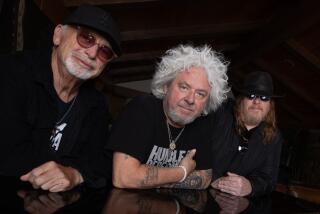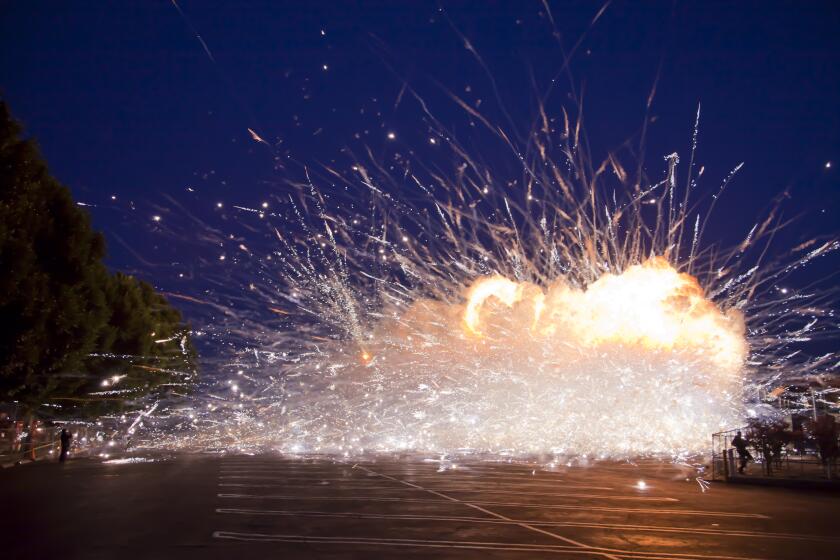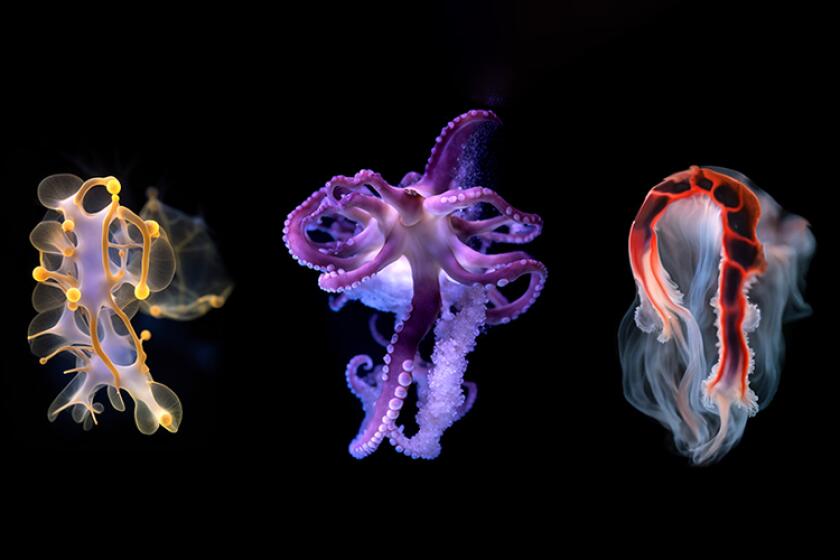The heiress and the architect
Like most architects, who exist from one project to the next, Frank Lloyd Wright lived in fear of being without work. He had already begun studies of the Imperial Hotel he would eventually build in Tokyo when he met Aline Barnsdall, an oil heiress and patron of the performing arts who wanted to commission a small theater in Chicago.
As the project grew to a house surrounded by an arts complex, the venue changed from Chicago to Los Angeles. The ambitious scheme was never completed, but by 1921 it produced a remarkable house that signaled a radical change in Wright’s style.
Hollyhock House, which Barnsdall named for the flowers that grew wild on the site, was unlike anything Wright had designed before, or that even existed at the time. The 36-acre city block known as Olive Hill, in what is now eastern Hollywood, was a legendary hilltop location with views of the city and ocean. But where Taliesin, Wright’s Wisconsin estate, opened out to a verdant landscape, Hollyhock House was built around a central courtyard and pool; water moved through and around the building and the landscape as an integral part of the scheme.
The entrance was through a temple-like block with a frieze of stylized hollyhocks. The house, stylistically novel, suggests many influences: Aztec, Mayan, Egyptian and pre-Columbian Mexican. If the look was archaic and vaguely Mesoamerican, the symmetrical plan and flanking wings still had a Beaux Arts formality.
One designer who saw early sketches of the house found it startling and enchanting. He called it “a miniature palace of some ancient civilization.” Wright called it “simply Californian.” In a sense, he was right.
It was an invention, and Southern California in the early 1920s was inventing itself. The movie industry, only recently arrived, was an exhilarating exercise in the glamorously unreal; Hollywood was a state of mind, a fantasy. Wright saw himself devising an indigenous architecture where none existed, creating a fairy-tale identity for a land that had been settled by strangers and their imports from home. Much of the land was still wildly, profligately beautiful. Agnes de Mille has recorded her childhood memories of running through endless fields of brilliant flowers, when her uncle, Cecil B. DeMille, was making his epic films.
The sets for those films -- Babylonian, Roman, Middle Eastern -- were also part of the landscape. They were left standing where they were constructed, coexisting with the poppies and eucalyptus. Illusion defined perception and set the terms of occupation. Stars and studio heads built mansions in appropriated styles from French chateaux and English manor houses to Spanish colonial haciendas. The promised land was becoming a never-never land of architectural make-believe. Wright condemned it all as derivative and artificial -- an architecture of default.
He believed that a new, more suitable architecture was needed, and that he, of course, would create it. The style would be American, and identifiably his own. Unlike his European counterparts, who rejected the past, Wright was not above seeking ideas in history and geography, although he would never acknowledge the sources of the forms and conventions that he used.
Ancient and primitive cultures had intrigued him since he had observed their influence on contemporary European art while he was abroad in 1909. He had seen exhibits of pre-Columbian cities and temples in Mexico and Central and South America as early as 1893, at the Chicago World’s Fair.
Wright considered the buildings of these early American civilizations, with their bold, monolithic forms and intrinsic decoration, closer geographically and culturally to California’s lush landscape and benign climate than traditional styles imported from Europe or the East Coast.
He gave his invention a name, California Romanza. In music, he explained, romanza was “free form, or freedom to make one’s own” -- something that seemed a perfect fit for the time and the place. Hollyhock House was also the stuff of dreams. The construction, which only looked like solid stone or concrete, was plaster over lath. Wright’s romanticism was totally at odds with the austere anti-aesthetic minimalism that was gaining ground in Europe.
Wright tells the story of Hollyhock House with the wit and charming mea culpa that kept the faithful coming back for more outrageous behavior and extraordinary buildings. He was, he admitted, more interested in his creation than in the client, an apology tinged with “after all, how could it be otherwise?”
The house was built “by proxy,” as he put it, while he was working in Japan. Construction had to be entrusted to others, and there were problems of design and execution. Supervision was delegated to his son Lloyd and an associate, Rudolf Schindler, and he blamed them for everything that went wrong or displeased him, listing their deficiencies with cruel precision. But much was Wright’s own fault, and he knew it. He was accustomed to resolving the practical details of his designs during construction, and he had not been there when needed.
Faced with an unconventional building and an absentee architect, the contractor complained of a lack of working drawings, and followed the common practice of urging compromises on the client. The client, in turn, was constantly advised by her “entourage of friends,” as Wright described them in half-humorous accusations, who knew as much about the building, he said, “as Sodom knew of Sanctity.” Absorbed in the construction of the Imperial Hotel, “in utter weariness,” he had abdicated control.
To make things more difficult, the architect’s and the client’s egos were a strong-willed match. Mercurial and self-absorbed, used to doing as they pleased and getting what they wanted, his willful, wealthy, women clients were not easy to deal with. Wright found Barnsdall particularly troublesome. She was given to running off to distant parts of the globe to “refresh” herself whenever decision-making threatened.
Her architect was equally free-floating. When she was in California, he was in Japan; when he came back, she was gone. En route, “she would drop suggestions as a war-plane drops bombs and sail away into the blue.” He wondered what she needed a house for, since she was “as domestic as a shooting star.” He wrote in retrospect, “Though both architect and client were torn to tatters, ‘Form’ got into the building despite all folly.” It was the “idea” of the house that mattered to him, “the thing of beauty” that he tried to nurture from afar, and that, “miraculously,” he said, was finally achieved.
The house’s large living room, a classic double cube, was warmed by the golds and browns of Wright’s furnishings and a magnificent gold-ground Japanese screen. The room focused on the hearth, but this one differed radically from those in Wright’s earlier houses. Built of concrete block rather than brick, and embellished with abstract designs, it projected into the room, occupying its own space. Instead of drawing one deeply into a shadowed, embracing isolation, it was placed beneath a skylight, with light flooding from above. Even more unusual, it was set into a shallow pool of water at its base. Like some ceremonial symbol for the life of the house, it suggested life itself; all of the elements were there -- fire, water, earth and air.
Barnsdall did not stay long in Hollyhock House; she seldom alighted anywhere for long. With her ideas of “democratizing” art, and her association with bona fide radicals of the day, she was considered a “parlor Bolshevik” in Hollywood. The divide was exacerbated by the fact that she lived grandly, cut off from the city and its inhabitants in elegant, artful and extravagant architectural seclusion on the hill.
To Wright’s consternation, she suddenly “gave it all away,” donating the house and land at the intersection of Hollywood Boulevard and Vermont Avenue to the city of Los Angeles, which dithered about accepting it until 1927, and did so finally through an arrangement with a California arts group, which had neither the means nor the expertise to deal with the building.
Treated with minimal appreciation and casual conservation, the house deteriorated badly. Municipal caretakers added the ultimate insult of a chain-link fence. The private-public coalition that finally undertook its restoration and maintenance after many years of neglect struggled with a chronic lack of funds. (The first half of a two-phase restoration of the grounds and house was completed last year.)
When Wright returned from Japan in 1922, he had confidently expected to find himself famous and besieged by clients, with the completion of the Imperial Hotel (and its later survival of an earthquake that leveled most of Tokyo in 1923), but he discovered he had been essentially forgotten in the four years he spent working abroad.
Wright had also committed the original architectural sin of conforming to no ideology except his own, and the equally unforgivable sin (to defenders of Modernist dogma) of changing styles whenever he wanted.
By 1923, Wright was referring to the stylistic extravagance of the Imperial Hotel and Hollyhock House as an “indulgence”; he had strayed far from his own avant-garde principles in following an aberrant, picturesque path.
*
Ada Louise Huxtable is architecture critic for the Wall Street Journal.
*
From “Frank Lloyd Wright” (2004) by Ada Louise Huxtable, published by Viking, a division of Penguin Group (USA) Inc., and Lipper Publications.
*
Want a tour?
*
Hollyhock House is closed for renovation. Tours of the exterior are available by appointment from 12:30 to 3:30 p.m. Wednesdays through Fridays. Docent-led tours for drop-ins are from 12:30 to 3:30 p.m. Saturday and Sunday.
“Restoring the Romanza: The Rehabilitation of Hollyhock House,” a documentary, plays at the Municipal Art Gallery at Barnsdall Art Park noon to 5 p.m. Fridays through Sundays, noon to 9 p.m. the first Friday of the month.
The house and park are at 4800 Hollywood Blvd. Call (323) 644-6269 or go to www.hollyhockhouse.net.
More to Read
The biggest entertainment stories
Get our big stories about Hollywood, film, television, music, arts, culture and more right in your inbox as soon as they publish.
You may occasionally receive promotional content from the Los Angeles Times.






